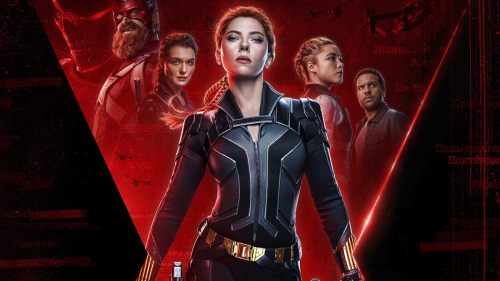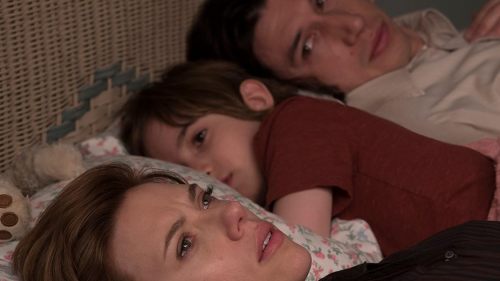SCARLETT JOHANSSON, Transhuman
Ghost in the Shell hits theaters this week! Get your tickets here!
As of last year, Scarlett Johansson is the highest-grossing actor in Hollywood. And I don’t mean the highest-grossing actress. Johansson’s films brought in $1.2 billion in 2016—more than any other actor of any gender. If money is power, then Johansson has both. At this point, she presumably has her pick of any script she likes, because that’s what you get when your name tops the A-list. That’s also why it’s fascinating that her next starring role is Ghost in the Shell.
There are plenty of reasons Johansson might have coveted the role of badass Major Motoko Kusanagi in this adaptation of the well-loved manga. For starters, if the film performs well, it’ll certainly provide her with a franchise vehicle she won’t have to share with Captain America. And the Major will also doubtlessly be a physically demanding role, something Johansson has shown a knack for in her work within the Marvel Cinematic Universe. But strangely enough, I suspect Johansson picked Ghost in the Shell, and may well excel in the role, because her character is not, and can never be, fully human.
The Major is a transhuman cyborg whose body is a lethal killing machine that she uses to great effect during the course of her highly classified job in a spec-ops counterterrorism unit. Once a human girl, she’s been transplanted, modified, and cybernetically enhanced until little remains of her original flesh and blood. In the manga and its anime adaptations, this metamorphosis from human to something more comes at a great emotional price, causing the Major to obsess over her identity and the meaning of her existence.
A woman who becomes disconnected from her humanity and suffers an existential crisis as a result? That’s the kind of role Johansson knocks out of the park. It’s also a niche she clearly seems interested in mining, and with good reason. Johansson garners a lot of critical acclaim when she takes on these transhuman characters. Her performances are more nuanced, challenging, and engaging when the role is not-quite-human.
Johansson dipped her toes in the existential wading pool with Sofia Coppola’s Lost in Translation. Her character Charlotte is no cyborg, certainly, but she is a woman who feels less than fully human: socially isolated in an inaccessible foreign country, divorced from her own feelings, and in a state of grave uncertainty about the meaning of her own life. Johansson’s subtle performance relies heavily on vulnerable body language and intimate silences, and it lends Charlotte a gravitas that seems beyond the reach of an 18-year-old actress. In a wordless scene, Charlotte visits Kyoto’s tremendously beautiful Heian Shrine and watches with a mix of longing and detachment as a newlywed couple passes by. When she finally speaks, it’s to reinforce the fact that her lovely exterior does not reflect the disaffection she feels inside. Later, Charlotte tells a friend over the phone, “I didn’t feel anything.”
Emotion is fundamentally human. So naturally, losing the capacity to experience emotions in the usual way is a hallmark of the transhuman character. This transition happens almost instantly for Lucy, Johansson’s character in the Luc Besson’s film of the same name. A young woman accidentally dosed with a drug that enhances her mental faculties, Lucy evolves from a frightened white girl in a scary situation to a Swiss Army knife of a human being capable of telepathy, telekinesis, and calculated murder. She sheds her humanity a little too effortlessly, perhaps, robbing Lucy of much tension between the title character’s human and transhuman identities. Lucy isn’t Besson’s finest work, and it feels as though something got lost in the editing process. As written on the page, though, the character’s appeal for Johansson is apparent: Lucy advances so far beyond her essential humanity that even an innocent sip of champagne will cause her body to literally disintegrate.
Johansson’s most in-depth explorations of transhuman identity are inarguably her roles in Spike Jones’ Her and Jonathan Glazer’s Under the Skin. Both released in 2013, the two films see the actress approach her more-than-human characters in two radically different ways. In Her, Johansson’s character Samantha is an artificially intelligent operating system, depicted as a disembodied voice who easily passes the Turing Test within her first few lines. Samantha seems more vital and emotionally intelligent than the human beings in the film, but she struggles with her non-corporeal nature, especially as she begins to fall in love with a human. Even though she’s an incalculably intelligent being with the emotional capacity to carry on 641 loving, intimate relationships simultaneously, Samantha still suffers from deep insecurity because she cannot provide one of her boyfriends with physical love and affection the way a human woman could.
In Under the Skin, Johansson plays an unnamed character credited as the Female, an otherworldly visitor who procures a human body for herself in order to prey on unsuspecting men. Unlike Samantha, the Female is all physicality with minimal dialogue. Johansson is fully nude in the film, and it’s some of the most utterly nonsexual nudity in recent cinematic memory. In one scene, the Female examines her naked body in a mirror, her face devoid of expression. She feels neither pride nor insecurity when she looks at her body, because it’s not her body, after all, it’s just the one she found. And because she’s not human, the conflict between the Female’s human and transhuman identities comes from without, rather than within. The men she lures back to her black, void-like den certainly have feelings about her body, along with concrete plans and expectations for it. The Female struggles to process the meaning of their sexual designs on her. After a particularly harrowing scene where she nearly has sex with one of her victims, the Female sits at the edge of the bed, naked, examining her genitals. It’s unclear if she’s experiencing fear, confusion, or anger, but it is clear that she feels deeply conflicted by what the man wanted from her, and perhaps by the manner in which her stolen body might have accommodated that desire.
Scarlett Johansson’s acting feels the most real when her characters aren’t quite human, don’t quite know who they are, and aren’t perceived as exactly real by other people. Perhaps it’s presumptuous to offer any conjecture as to why these roles appeal to her, and why they often coax out her best work, but I’ll hazard an educated guess that they hit close to home. Johansson has worked as an actress since her film debut at nine years old. In her 30s now, she has spent the vast majority of her life in the public eye, and she freely admits that her celebrity has been an alienating experience for her, especially when it comes to connecting with people. When she interacts with the public, Johansson has stated in interviews, she feels like something of a specimen: “There’s a disconnect. I’ve had people come up to me on the street and be very inappropriate, or in really private settings, like the hospital. It never ceases to amaze me, but there’s a feeling that you can’t possibly bother that person, because they’re not real. They’re famous.”
If everyone I met treated me like I wasn’t real, I’d feel pretty eager to play a lethal cyborg, too.



